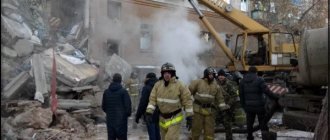Gas holder - the name was borrowed from English. Gas – gas and holder – holder, owner. Under the loud name there is simply a storage tank for a gaseous substance. Most often, residents of private houses pump and store natural or liquefied gas into such containers. Heating systems that include solid fuel or diesel boilers may often not suit homeowners due to labor-intensive maintenance.
An alternative in this case is a high-tech gas boiler, but what to do when the main gas pipeline is too far from your home, or is completely absent? A gas tank comes to the rescue. The use of such a device is not at all uncommon in the modern world. A correctly selected gas tank, depending on the volume and corresponding gas consumption of the boiler equipment, is capable of providing a country house with fuel, requiring replenishment only twice a year.
What is a gas holder?
A gas holder is nothing more than a container designed to store liquefied natural gas. If you want, this is such a huge lighter. Around the world, the use of gas tanks on households is completely common. It would never occur to a prudent owner to pull a branch from a main gas pipeline several kilometers away.
Gas holders are widely used in Europe, where resources are used sparingly and the traditions of autonomous gasification are firmly entrenched in the minds of homeowners. Often such a large cylinder can be found at ski resorts, or northern territories where it is not possible to lay a gas pipeline for geological or economic reasons.
Autonomous gasification is not hopeless at all. This is a completely sensible, balanced and widespread decision throughout the world. In the European Union, for example, Poland alone, there are more than 100 thousand similar gas supply options. Installing a gas holder helps households experience the benefits of using liquefied gas at home, such as convenience and economic benefits.
Currently, at the end of 2021, the rules for operating a gas tank in the Russian Federation regulate the registration of installed equipment with Rostechnadzor, if it belongs to a legal entity. If the equipment belongs to an individual and is installed on private property, there is no such regulation of registration requirements. Of course, it is worth understanding that the owner is responsible for everything independently.
Vertical or horizontal
Gas tanks that are installed vertically are of more interest to owners of small plots: this way they can comply with all placement requirements and save precious space. This is the most important advantage of vertical gas holders, and for this reason they are so popular in European countries.
In our country of large territories and high groundwater levels, the horizontal option is more common.
Andrey2 Member of FORUMHOUSE
It is cheaper to bury a horizontal one, but if the groundwater level is high, then the vertical one is more difficult to install.
About the fact that “vertical gas tanks have a small evaporation mirror, and with a large analysis there may be a lack of gas fraction” - on the portal there are quite a few owners of vertical tanks who did not feel any inconvenience at all from the small evaporation mirror.
Gas holder device
Gas holders are distinguished according to the principle of storing gaseous substances and are divided into two types: with variable and constant volume. In the variable type, the gas is stored at a pressure equal to atmospheric values. The volume of such a container changes linearly depending on filling or emptying, and the necessary pressure is created by a special bell in a cylindrical pool filled with water or by a piston in dry systems.
Second type: constant volume gas holder. That is, it is a container that does not change the internal volume depending on the amount of gaseous substance injected. As a rule, they look like a cylindrical tank. Their main advantage is the modern materials used for their manufacture, which are capable of containing gas under a pressure of 1.8 MPa.
Above ground or underground
Based on the type of occurrence, reservoirs are divided into above-ground and underground. In most cases, Russian homeowners choose underground ones. This is a dire necessity. How a gas tank works: at positive temperatures, the liquefied fuel in it evaporates and turns into gas, the valve opens, and the gas flows through the gas pipeline into the house, to the boiler. Under the ground around the walls of the container there are always positive temperatures - this is the main advantage of an underground gas tank. And the ground-based one may need to install special evaporators.
CrimsonFORUMHOUSE Member
That’s why large gas tanks are buried to prevent them from freezing. And preferably with a high neck, so that the gas itself is deeper - it’s warmer there.
But some owners of gas tanks believe that all tanks, regardless of the type of location, need additional heating of the gearbox.
StanspbFORUMHOUSE Member
In winter, it can freeze to very low temperatures, crack and stop regulating the gas supply. So I consider it necessary to heat the gearbox.
There is another type of gas holder - mobile or portable.
Usually this is a gas tank for the country - a cylinder with a capacity of about 700 liters on a car trailer that can be transported to a gas station. Mini gas holders cope with their tasks quite well.
MosKvachFORUMHOUSE Member
The mobile is placed on the base or works directly from the trailer. Moreover, there are also winter kits to prevent freezing in cold weather.
Why is a gas tank needed?
In order to save their costs and make more profits, developers are not willing to extend highways to new buildings. The owner of a private house may, in this case, think about autonomous gasification of his home. If the mainline is significantly removed, a gas tank becomes an alternative solution. Why is this necessary? For three reasons: convenience, economy and ecology. Of course, you can heat your house with coal, fuel oil, diesel fuel or even wood.
If any of the above options are comparable in cost, then they are definitely not environmentally friendly. As for the economy, if you consider that the price of a kilogram of liquefied gas at the time of 2021 is about 30 rubles (on average = 0.5 dollars). An eight-month heating season for a house with an area of 150 square meters. will require from 3000 to 4000 kilograms.
Thus, the total financial costs for heating, heating water to a hot state and cooking food are approaching 90-120 thousand rubles per year. Or 7 – 10 thousand rubles per month, for complete energy independence. However, we will make a reservation that the actual amount of costs depends on the materials used to build the house, the insulation used and the area.
Gas holder placement rules on the site
An autonomous heating system using a gas holder today requires large one-time investments. That is why it is not advisable to use a gas tank for a private house with an area of less than 150 square meters, due to the long payback period of the project.
The basis for gasification of the facility is the gas tank. Or, as we found out, a liquefied gas storage facility. Gas is delivered by special gas carriers, which pump it into the tank. The volume of the required gas tank is calculated based on the size of the house.
Practice shows that normal household use is limited to a size of 2.5 - 5 cubic meters. The tank is buried in the ground, at a certain distance from the house, so that the gas holder can be refilled without hindrance, and the gas carrier can park without any difficulties.
The depth of the container is also important. Preference should be given to manufacturing companies that manufacture gas holders taking into account the freezing depth. The design must have a high neck.
Please note that European manufacturers do not always make a high neck, since it is not necessary in southern latitudes. We can only envy that not all of Europe is familiar with the concept of “freezing depth”.
Many consumers buy a container without a neck, saving a small amount of money, and then, when faced with difficulties, begin to heroically overcome them. After installation, deepening the gas tank is not an easy and costly task, but expanding the neck becomes more difficult and many times more expensive.
In any case, it will not be possible to leave the gas holder near the surface. The physical properties of propane-butane do not allow for high-quality operation of the device at subzero temperatures, preventing the liquefied phase from effectively evaporating.
In addition, pay attention to the service life of the container. Often a gas tank with no neck has a limited service life and does not exceed 20 years. After this time, the container simply needs to be replaced, since there is no way to diagnose it.
Bury the gas tank in a horizontal position. This achieves two goals. Firstly, it is much easier to dig a hole and ensure inexpensive installation of the structure. Secondly, the gas evaporation surface expands. Evaporation occurs naturally, and its quantity is enough to provide a country house with the vapor phase of gas. Otherwise, it would be necessary to use separate mechanisms - so-called evaporators.
Profit or ruin
How profitable is a gas tank, does it pay for itself, and when does it make sense to install it in a country house or country house, and when not? This issue has been discussed on FORUMHOUSE for many years. There is no universal answer here, each case is individual, it all depends on the size and quality of insulation of the house, the climate of the region, and the prices of other types of fuel.
But here are the things we managed to agree on:
- Gas tank heating will be more profitable if you fill the tank once a year, in May. The cost of fuel in May is 20% lower than in October. But for this, the tank must have a sufficiently large volume.
- Gas holder heating is definitely cheaper than diesel heating, and in a number of regions of our country in terms of return on investment it ranks second after natural gas;
Westpoint FORUMHOUSE Member
Barrels with a volume of 4850 for a house of 130 sq.m. Should be enough for a year with a one-time refill. This is half of what I spend on pellets now.
- If the area of the house is more than 100 square meters, an autonomous gas heating system based on a gas holder may already be appropriate. If you just need to heat a small dacha, it would be better to go with electricity.
spbplumbing FORUMHOUSE Member
It all depends on capital investments, but a gas holder will be cheaper than a diesel boiler with piping, a chimney, a container, and installation.
KhrunchaModerator FORUMHOUSE
Personally, I don’t regret at all [that I buried the gas holder]. Ownership experience 8 years.
Even those people who loudly regret having installed gas tanks do not want to sell them.
Here are some reviews of how much home heating with LPG cost users of our portal last year 2021.
MblParticipant FORUMHOUSE, Moscow.
The total area is 150 square meters + sauna 70. Of these, I constantly heat 60-70 m to + 21 degrees, in the sauna I maintain +5 all week, and +21 on weekends. Consumption per year under this regime is 40,000-45,000 rubles. There are about 2500 liters. I have a barrel with a volume of 4850 liters.
A member of our portal with the nickname IlyaKu has been operating a 6400 liter gas tank for four years. The area of his house is 10 square meters, and he chose such a large tank, planning to subsequently connect his relatives’ house to it. Both houses are permanent residences, without heated floors, with radiators.
IlyaKuForumHouse Member
While there was one house of 160 m2, there was enough fuel for the whole year and with a huge supply, the supply allowed you to choose when it was more profitable to refuel (minimum price May-June, maximum October-December).
After connecting the second house, a house with an area of 140 m2 has to be refueled twice a year, in total for two houses in 2021 it came out to 119,000 rubles, in the past 129,000.
FORUMHOUSE members who live close to each other find partners on the forum to refuel together. Judging by the reviews, this allows you to save from 50 kopecks to a ruble for each liter - it is much more profitable for gas stations to carry full tanks.
But this is about fuel consumption; Many people are more afraid of the cost of installing equipment. They are indeed considerable, but – and this can be looked at from different angles.
ChaleFORUMHOUSE Member
Believe me, compared to the cost of a house with some furniture and appliances, 350 thousand for everything including the first gas station will seem like a small amount.
Gas holder safety
A gas holder is not very different from a regular household cylinder, except in size. Reviews from owners indicate the unpretentiousness of the equipment in general. Filling with gas, just like a cylinder, should not exceed 85% of its volume.
Evaporating, the gas phase enters the house through the gas duct and powers heating, hot water and other gas appliances. A mandatory safety principle during operation is the use of a group of special devices that monitor leaks of the gas mixture. Thermal shut-off valves block the gas supply to the house in the event of a fire.
Gas alarms paired with a solenoid valve during a leak and a gas concentration of 0.4% send a pulse to the valve and completely block the supply of the gas mixture to all appliances in the house.
A sensitive gas analyzer is installed near the floor, where possible leakage will accumulate; a wire runs from it to a valve fixed on the gas pipe. The critical concentration of propane-butane starts from 2% of its content in the air. Such a pair is not cheap, but it is a reasonable price for complete safety.
Gas holder for a private home: pros and cons
The advantages of owning a gas holder in a personal household are obvious, we just have to state the facts:
pros
- autonomy - the consumption of gas resources becomes available to you in full. Your personal gas pipeline system does not depend on pressure in the mains. You are not afraid of accidents of the common gas pipeline. In addition, such equipment significantly affects the capitalization of your home;
- environmental component - do you want to walk on snow-white snow in your country house, creaking on the paths? Then urgently give up fuel oil, diesel fuel and coal. The almost complete absence of sulfur compounds in liquefied gas, and its complete combustion with sufficient air, guarantees snow-white snow and clean air. Even if the gas tank fails and gas escapes, nothing terrible will happen. Liquefied gas quickly passes into the vapor phase and evaporates into the atmosphere. You don't have to worry about harming the ground cover or seedlings;
- increased service life of your entire farm. Boiler equipment running on gas fuel always has an undeniable advantage in the form of a long service life over solid fuel or liquid fuel boilers. The fact is that the absence of sulfur has a beneficial effect on interaction with metal. Having no reaction with sulfur, gas equipment will work faithfully 30% longer compared to traditional heating units;
- odorless combustion - modern gas equipment is everywhere located in high-rise apartments. The combustion processes of blue fuel in devices occur without the release of pungent odors, and harmful products are removed outside through a chimney.
The disadvantages that a gas tank can give us are not so obvious. For the most part, they are all connected in one way or another with the increasing financial burden on home ownership:
Minuses
- Price
– financial costs for a full range of services for connecting a gas tank, which is called “turnkey”, will cost the owner starting from $3,500. Additionally, you will have to buy control valves, gas analyzers and other metering devices. Ensuring the access of a gas carrier so that gas delivery and gas holder refilling can be carried out without hindrance. Add here the annual maintenance;
- Increased responsibility - the gas in the tank is an explosive substance. You should remember safety measures and, if possible, bury the gas tank in the ground at the maximum distance from residential buildings. The minimum distance is considered to be 10 meters; the depth, as a rule, corresponds to the lower level of soil freezing. As we wrote above, limit yourself to filling the storage tank to no more than 85% of the volume. Remember, gas is a substance that can expand, especially in the summer.
- Routine check – the gas tank requires regular maintenance. Taking into account the passport data of the tanks, in accordance with the current rules and standards, only specially trained persons who have passed certification are allowed to perform maintenance. The entire system must be constantly monitored for gas leaks. Monitor the amount of it in the tank so as not to end up in a situation where the tank is empty and then the heating system stops. A telemetry module can be an assistant in solving many problems. As you might guess, this pleasure is not free, but the installation monitors and transmits information about the status of the equipment via the Internet or cellular communications;
- condensation formations - evaporation occurs inside the gas tank, particles fall onto the walls in the form of condensation, the process destroys the equipment and can gradually damage the tank.
Autonomous gasification and gas supply to a private home - watch the video:











